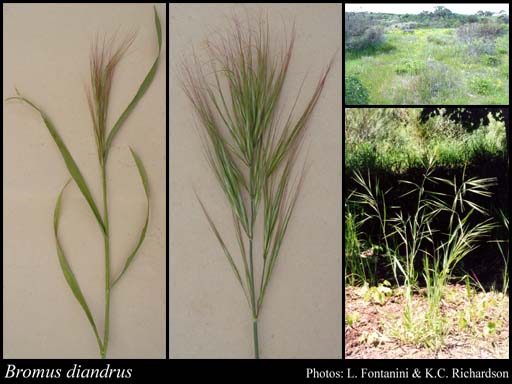- Reference
- Bot.Abh.Beobacht. 44-45 (1787)
- Conservation Code
- Not threatened
- Naturalised Status
- Alien to Western Australia
- Name Status
- Current
Tufted annual, grass-like or herb, 0.2-0.7 m high. Fl. purple/yellow-green/cream, Aug to Nov. Yellow/grey/black sand, loam, red/brown clay.

Distribution
- IBRA Regions
- Avon Wheatbelt, Carnarvon, Coolgardie, Esperance Plains, Geraldton Sandplains, Jarrah Forest, Mallee, Nullarbor, Swan Coastal Plain, Warren, Yalgoo.
- IBRA Subregions
- Dandaragan Plateau, Eastern Goldfield, Edel, Fitzgerald, Geraldton Hills, Katanning, Lesueur Sandplain, Merredin, Northern Jarrah Forest, Nullarbor Plain, Perth, Southern Cross, Southern Jarrah Forest, Warren, Western Mallee, Wooramel.
- IMCRA Regions
- Abrolhos Islands, Central West Coast, Leeuwin-Naturaliste, Shark Bay, WA South Coast.
- Local Government Areas (LGAs)
- Albany, Armadale, Augusta Margaret River, Beverley, Boddington, Bridgetown-Greenbushes, Bunbury, Busselton, Cambridge, Canning, Capel, Carnamah, Chapman Valley, Chittering, Cockburn, Coorow, Corrigin, Dalwallinu, Dandaragan, Dardanup, Donnybrook-Balingup, Dowerin, Esperance, Gingin, Gnowangerup, Goomalling, Gosnells, Greater Geraldton, Harvey, Jerramungup, Joondalup, Kalamunda, Kalgoorlie-Boulder, Katanning, Kojonup, Kwinana, Mandurah, Manjimup, Melville, Merredin, Mingenew, Murray, Nannup, Narembeen, Narrogin, Nedlands, Northam, Northampton, Perth, Pingelly, Plantagenet, Quairading, Rockingham, Serpentine-Jarrahdale, Shark Bay, South Perth, Swan, Tammin, Toodyay, Trayning, Wagin, Wanneroo, Waroona, Wickepin, Wongan-Ballidu, Woodanilling, Wyalkatchem, Yilgarn, York.
Management Notes (for the Swan NRM Region)
Alternative Names. Ripgut brome, giant brome, Kingston grass, brome grass.
General Biology. Growth form. Grass. Life form. Annual, caespitose. Reproduction. Seed. Dispersal. Mammals, wind, machinery, clothing, contaminated crop seed. Photosynthetic Pathway. C3. Seedbank persistence. Short, days to 2 years. Fire response. Unknown, however the seed remains in the inflorescence longer than most desirable grasses, where they are susceptible to direct heat from fire.
Notes. Naturalised across southern Australia due to aggressive spread and pre-adaptation to temperate Mediterranean climates. Similar to the native Bromus arenarius (sand brome) which has an earlier flowering period of July to October. Highly competitive for water, nutrients and space and adapted to a range of soil types from acidic to alkaline and sand to loams. Drought tolerant. Produces prolific seed. Seed remains dormant in high temperatures over summer but are highly germinable when conditions become suitable. Rainfall is the biggest determinant for germination. Most seed will germinate with first substantial rain in autumn/early winter. In dry starts to seasons, a greater proportion of the seeds show staggered germination which may continue until as late as August. Under increased nitrogen, seedlings emerge earlier at higher densities.
Additional information. Origin. Mediterranean. History of use/introduction. Introduced into Australia circa 1875 as a contaminant of crop seeds or wool. Similar exotic species. Bromus rigidus. Similar native species. B. arenarius.
Suggested method of management and control. Prevent seed set. Hand pull plants. In degraded areas use 1% glyphosate on seedlings, young plants or when flowering. Alternatively spray plants at 3-5 leaf stage with Fusilade® Forte at 16 ml/10 L or 800 ml/ha (based on 500 L water/ha) + wetting agent or for generic fluazifop-p (212g/L active ingredient) 10ml/10L or 500ml/ha + wetting agent. An early and late application may be required where two Bromus species are present. Repeat the following year if required. Read the manufacturers' labels and material safety data sheets before using herbicides. For further information consult the Australian Pesticides and Veterinary Medicines Authority to determine the status of permits for your situation or state.
Management Calendar
| Calendar Type | Jan | Feb | Mar | Apr | May | Jun | Jul | Aug | Sep | Oct | Nov | Dec | Comments |
|---|---|---|---|---|---|---|---|---|---|---|---|---|---|
| Active Growth | Y | Y | Y | Y | Y | Y | |||||||
| Germination | Y | Y | O | O | |||||||||
| Flowering | Y | Y | Y | ||||||||||
| Fruiting | Y | Y | |||||||||||
| Optimum Treatment | Y | Y | Y | O | O | O |
Legend: Y = Yes, regularly, O = Occasionally, U = Uncertain, referred by others but not confirmed.
References
- Abraham, J.K., Corbin, J.D. & D'Antonio, C.M.D. (2009) California native and exotic perennial grasses differ in their repsonse to soil nitrogen, exotic annual grass density, and order of emergence. Plant Ecology, 201: 445-456.
- Bowcher, A., Cheam, A., Gill, G. & Moore, J. (Undated) Weed 3. Brome grass. Department of Agriculture Western Australia URL: http://www.agric.wa.gov.au/objtwr/imported_assets/content/pw/weed/major/brome.pdf.
- Brown, K. & Brooks, K. (2002) Bushland Weeds: A Practical Guide to their Management. Environmental Weeds Action Network, Greenwood.
- Carr, G.W., Yugovic, J.V. & Robinson, K.E. (1992) Environmental weed invasions in Victoria. Department of Conservation and Environment, Melbourne.
- Cheam, A.H. (1986) Patterns of change in seed dormancy and persistence of Bromus diandrus Roth. (great brome) in the field. Australian Journal of Agricultural Research, 37 (5): 471 - 481.
- Cheam, A.H. (2005) The biology of intractable weeds. Brome grass: a persistent but manageable weed. Department of Agriculture Farmnote No 95/96. Department of Agriculture.
- DiTomaso, J.M., Brooks, M.L., Allen, E.B., Minnich, R., Rice, P.M. and Kyser, G.B. (2006) Control of invasive weeds with prescribed burning. Weed Technology, 20 (2): 535-548.
- Hitchmough, J.D., Kilgour, R.A., Morgan, J.W. & Shears, I.G. (1994) Efficacy of some grass specific herbicides in controlling exotic grass seedlings in native grassy vegetation. Plant Protection Quarterly, 9: 28-34.
- Hoopes, M.F. & Hall, L.M. (2002) Edaphic factors and competition affect pattern formation and invasion in a Californian grassland. Ecological Applications, 12 (1): 24-39.
- Hussey, B.M.J., Keighery, G.J., Dodd, J., Lloyd, S.G. & Cousens, R.D. (2007) Western Weeds. A guide to the weeds of Western Australia. 2nd Edition. The Plant Protection Society of Western Australia, Victoria Park.
- Kleemann, S.G.L. & Gill, G.S. (2006) Differences in the distribution and seed germination behaviour of populations of Bromus rigidus and Bromus diandrus in South Australia: adaptations to habitat and implications for weed management. Australian Journal of Agricultural Research, 57 (2): 213-219.
- Moore, J.H. & Wheeler, J. (2008) Southern weeds and their control. DAFWA Bulletin 4744.
- Swarbrick, J.T. & Skarratt, D.B. (1994) The bushweed 2 database of environmental weeds in Australia. The University of Queensland, Gatton College.